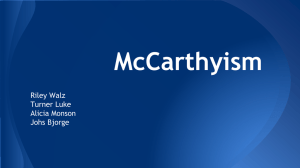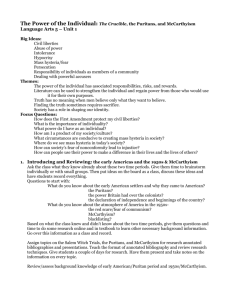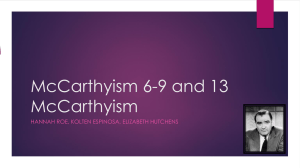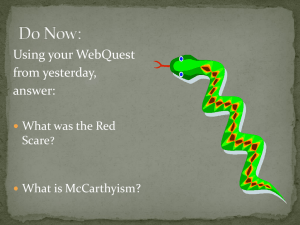The Crucible and McCarthyism
advertisement
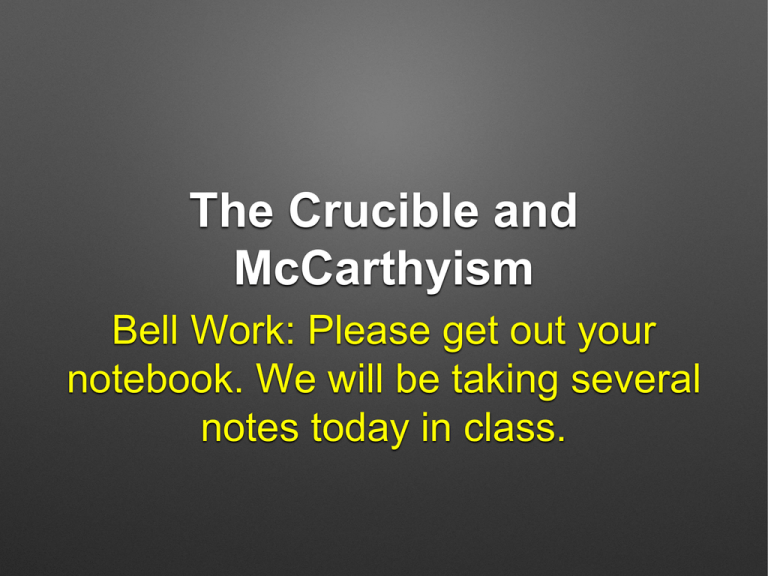
The Crucible and McCarthyism Bell Work: Please get out your notebook. We will be taking several notes today in class. Historical Context • To varying degrees, every literary work reflects its historical context- the social and political conditions that shaped the culture of its time. The Crucible, produced in 1953, grew out of the controversy surrounding Senator McCarthy and his anti-communism campaign. Political speeches on both sides of the campaign contained logical fallacies. See next slide for more details! Logical Fallacies Either/Or Fallacy insists that only two choices exist in a complex situation, as when a politician says, “You’re either with us or you're against us." Logical Fallacies Name-Calling occurs when politicians point the finger of blame, accusing their opponents of moral failings or lack of patriotism. Logical Fallacies Overgeneralization - when politicians lump all the members of an opposing group into a single negative stereotype Logical Fallacy False Cause - When a politician suggests that an opponent or an opponent's policies are to blame for what is wrong with the country. • Objectivity: provides balanced information on a subject • Subjectivity: a personal stake in the subject that affects the writer’s stance. The pitch, the complaint, and the moment • There is no such thing as "just information." Everything you read, to varying degrees, is aware of you, the audience, and is dealing with you in some way. • One of the most productive ways of analyzing a reading is to consider the frame within which a piece is presented: who its intended audience is, what is seeks to persuade that audience about, and how the writer presents himself or herself to appeal to that audience. • Readings virtually never treat these questions explicitly • What does this mean? The pitch, the complaint, and the moment • An element of situating a reading rhetorically is to locate what it seeks to accomplish and what it is set against at a given moment in time. We address these concerns as a quest to find what we call the pitch, the complaint, and the moment. The pitch • What the piece wishes you to believe The complaint • What the piece is reacting to or worried about The moment • The historical and cultural context within which the piece is operating To better grasp the historical context of The Crucible, take notes on what you learn as you read the selections and evaluate the objectivity of each source. An objective source provides balanced information on a subject. The first selection is about McCarthyism. As you read it, try to determine whether the article takes a position on the subject. Each of the other selections was written by someone with a personal stake in the issue at hand. As you read, look for evidence of subjectivity—a personal stake in the subject that affects the writer’s stance. McCarthyism Pages 351-352 • 1. Historical Context: What preoccupied Americans during the 1940s and 1950s? Record your answers in your notes. • 2. Reread lines 15-29 and use the information presented to define McCarthyism. Does this paragraph explain McCarthyism objectively or does it take a position on the senator and his campaign? Support your answer with evidence from the text. • 3. Identify the pitch, the complaint, and the moment. • The Demons of Salem, With Us Still Pages 353-356 • 1. Reread lines 61-78. In light of this comment, would you say that Elia Kazan took McCarthy’s mission seriously? Explain. • 2. Given her husband’s role in the McCarthy hearings, why do you think Molly Kazan might have objected to Miller’s comparison between HUAC and Salem? • 3. Which logical fallacy does a speaker commit by calling his opponents spies and “comsymps”? • 4. Identify the pitch, the complaint, and the moment. • Time Bends by Arthur Miller Pages 357-358 • 1. Reread lines 1-17. What details indicate the significance for Miller of finding Starkey’s book? • 2. As you have seen by reading these selections, politics, journalism, and literature can share ideas from a particular historical context. One article provides information on the McCarthy hearings; another addresses both the hearings and the writing of The Crucible. The third provides personal testimony from Miller himself. To synthesize what you have read, identify a theme or idea that runs through all three selections. • 3. Identify the pitch, the complaint, and the moment. Comprehension and Text Analysis Questions Page 359 # 1-5 • Read for Information: Synthesize • To answer the writing prompt, follow the steps on page 360.

